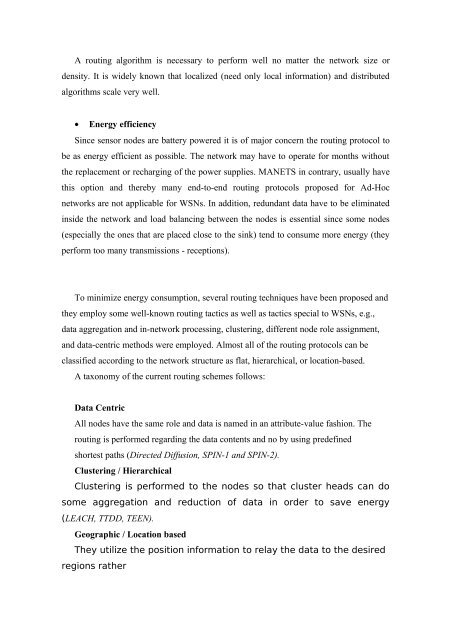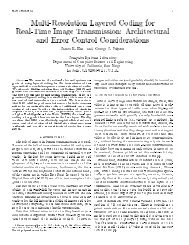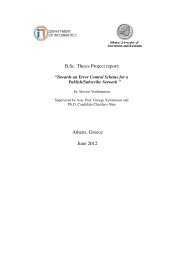In Network Processing and Data Aggregation in
In Network Processing and Data Aggregation in
In Network Processing and Data Aggregation in
You also want an ePaper? Increase the reach of your titles
YUMPU automatically turns print PDFs into web optimized ePapers that Google loves.
A rout<strong>in</strong>g algorithm is necessary to perform well no matter the network size ordensity. It is widely known that localized (need only local <strong>in</strong>formation) <strong>and</strong> distributedalgorithms scale very well.• Energy efficiencyS<strong>in</strong>ce sensor nodes are battery powered it is of major concern the rout<strong>in</strong>g protocol tobe as energy efficient as possible. The network may have to operate for months withoutthe replacement or recharg<strong>in</strong>g of the power supplies. MANETS <strong>in</strong> contrary, usually havethis option <strong>and</strong> thereby many end-to-end rout<strong>in</strong>g protocols proposed for Ad-Hocnetworks are not applicable for WSNs. <strong>In</strong> addition, redundant data have to be elim<strong>in</strong>ated<strong>in</strong>side the network <strong>and</strong> load balanc<strong>in</strong>g between the nodes is essential s<strong>in</strong>ce some nodes(especially the ones that are placed close to the s<strong>in</strong>k) tend to consume more energy (theyperform too many transmissions - receptions).To m<strong>in</strong>imize energy consumption, several rout<strong>in</strong>g techniques have been proposed <strong>and</strong>they employ some well-known rout<strong>in</strong>g tactics as well as tactics special to WSNs, e.g.,data aggregation <strong>and</strong> <strong>in</strong>-network process<strong>in</strong>g, cluster<strong>in</strong>g, different node role assignment,<strong>and</strong> data-centric methods were employed. Almost all of the rout<strong>in</strong>g protocols can beclassified accord<strong>in</strong>g to the network structure as flat, hierarchical, or location-based.A taxonomy of the current rout<strong>in</strong>g schemes follows:<strong>Data</strong> CentricAll nodes have the same role <strong>and</strong> data is named <strong>in</strong> an attribute-value fashion. Therout<strong>in</strong>g is performed regard<strong>in</strong>g the data contents <strong>and</strong> no by us<strong>in</strong>g predef<strong>in</strong>edshortest paths (Directed Diffusion, SPIN-1 <strong>and</strong> SPIN-2).Cluster<strong>in</strong>g / HierarchicalCluster<strong>in</strong>g is performed to the nodes so that cluster heads can dosome aggregation <strong>and</strong> reduction of data <strong>in</strong> order to save energy(LEACH, TTDD, TEEN).Geographic / Location basedThey utilize the position <strong>in</strong>formation to relay the data to the desiredregions rather








